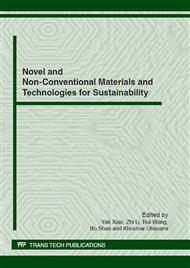p.96
p.101
p.107
p.112
p.118
p.127
p.135
p.141
p.150
Test Research of Glubam and it's Engineering Application
Abstract:
Bamboo is an ancient building material, but it is rarely applied in the modern buildings nowadays. The German-Chinese House in EXPO 2010 Shanghai China is mainly made up of bamboo members; it fully demonstrates the ideas of sustainable development and environmental protection. The 8m high pavilion is a two-storey building which is 25m long and 10m wide, and its first floor is 250 m2 and second floor is 80 m2. The exterior structure of the pavilion is made up of 96 JULONG bamboo canes whose diameter is approximately 200mm, and the inner two storey structure is made up of glubam beams and columns which have a section of 300mmX400mm. Obviously the designer had applied both the good compression capability of the pure bamboo canes and the excellent bending capability of the glubam members in this structure. As there is no bearing capacity data of the glubam, several tests for the glubam members had been carried and thus a lot of useful data had been got, therefore some structure analysis had been done. It indicates that glubam is a good structural material, and as a friendly environmentally building material, it can be widely applied in building engineering.[
Info:
Periodical:
Pages:
118-124
Citation:
Online since:
June 2012
Authors:
Keywords:
Price:
Сopyright:
© 2012 Trans Tech Publications Ltd. All Rights Reserved
Share:
Citation:


